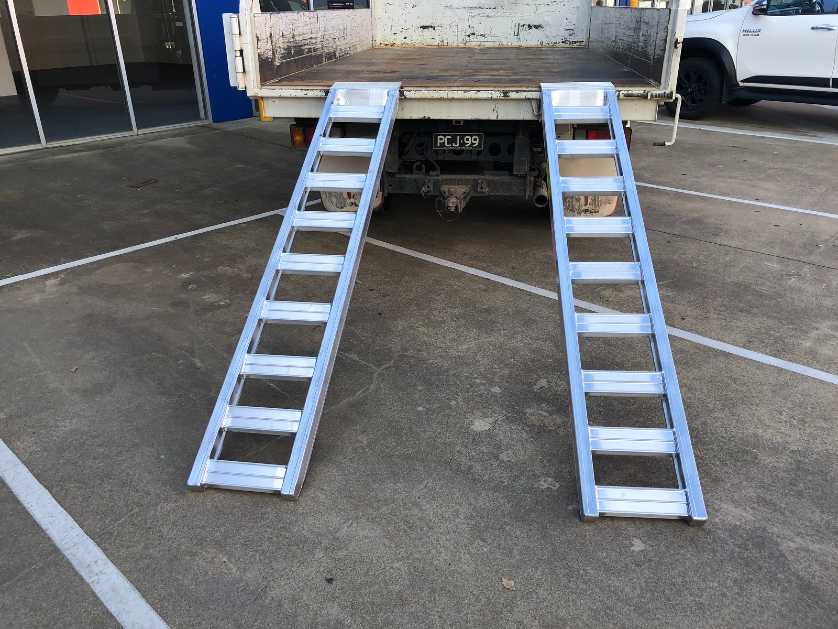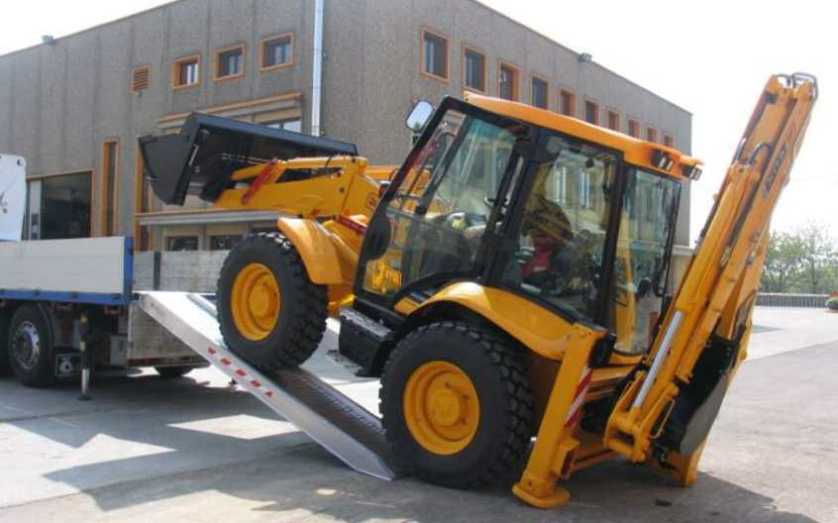If you typically transport medium-sized construction or garden machinery, either your own or someone else’s, the last thing you want to worry about is how it’s going to get on or off the truck or the trailer. It should be an uneventful affair, and most of the time it is. But sometimes it isn’t, and those are usually the times that ramp issues occur.
This is especially true if you’re a hotshot driver and you’re dependent upon someone else quoting you an accurate weight. No one wants to find themselves in a situation of uncertainty about the limits of their loading ramps, guessing about the suitability, or even availability, of someone else’s ramps. The key to avoiding any issues whatsoever is by having the right equipment; so, let’s talk a little about ramps.

source: rampitup.com.au
Contents
The right ramps
Loading or unloading a truck or trailer isn’t rocket science, but you can’t ignore weight ratings or other factors of ramp integrity. Insufficiently rated or poorly constructed ramps are dangerous, which is why you need to make sure you’re using high quality trailer ramps that are purposely designed and constructed to be strong, lightweight and durable.
It may seem like a tall order but coming up with a pair of ramps that match all these criteria isn’t difficult, and the stakes are too high to try fabricating your own. The one material that satisfies everything you could want from a ramp, and more, is aluminum.
Aluminum alloy ramps are strong, easy to transport and stow away, and easily set up by one person, making them the clear alternative to investing in substantially heavier steel ramps. In fact, tempered aluminum alloy ramps are just as strong as steel ones, with the added benefit that they won’t bend or rust. And let’s face it, aluminum trailer ramps even look better, too.
Rated for capacities up to six tonnes, it’s the open treadwork construction of these ramps and their wide range of lengths and profiles that allow for safely loading virtually any type of pneumatic wheeled vehicle or rubber-tracked machine. Plus, their ability to be positively secured directly to the floor or threshold plate of a truck or trailer using either fittings, solid pins, or straps helps eliminate the risks of accidental slippage during loading or unloading.
In short, it’s difficult to beat having a superior set of heavy duty aluminum ramps if you have machinery that needs to be moved, but having correctly rated ramps is really only the first step in getting loaded. There are right and wrong ways of doing it and after making a commitment to using the right equipment for the job, including a truck or trailer with an appropriate GVM rating, you also want to make sure the job is being done correctly from start to finish.
The right way to load
As routine as it may seem, loading and unloading machinery is very much about safe practices because not sticking with them can (… and eventually will) lead to damaging or destroying ramps and machinery, along with the risk of injuring a machine operator.
Where heavy machinery is concerned, an ounce of prevention can quickly prove its worth against several tons of cure, so follow these simple steps when using ramps:

source: pinterest.com
· Always verify the weight
While a heavy lawnmower or landscaping tractor with attachments may only weigh a couple of tonnes, a medium-sized backhoe can deceptively stumble in at five to six tonnes so you want to check (and if necessary, double-check) the weight of what you’re loading. Remember: ramps are only as strong as they’ve been rated in pairs, and going beyond that limit is an invitation for failure.
· Work from level surfaces
To keep undue lateral stress off the ramps, as well as minimize the risks of machinery tipping, ensure the loading deck and foot-ends of the ramps are as flat, and as parallel to the ground as possible. Foot-ends should never be positioned below the point where the truck or trailer tyres touch the ground. If they do, you need to consider looking for a different location to load or unload.
· Secure the ramps
In addition to making sure they’re adequately spaced, don’t forget to ensure the ramps are secured either by pins or chains, or whichever means the manufacturer provides to the loading deck. A ramp only needs to shift slightly to trigger an unstoppable, slow-motion disaster so take the handful of extra seconds needed to insert the pins.
· Minimize the ramp angle
Keep the angle of the ramps as low as possible, with 16° (30%) being generally regarded as the maximum angle of incline for ramp loading. Ramp manufacturers do calculate that into their construction but this is also a function of ramp length. It’s why longer ramps, relative to deck height, are preferred for heavier loads, and machines with longer wheelbases (or lower clearances) climbing steeper angles can rapidly complicate the matter. There’s no defeating physics on this so you want to have the longest ramps possible for whatever you intend to load.
· Load the powered end first
For all-wheeled or tracked vehicles, this isn’t an issue, but for machines like tractors or backhoes that only have drive power on a single axle, send that axle up the ramp first. There’s no defeating the physics on this one, either, and you’ll immediately notice how less likely your machinery is to flip off the ramps or the trailer doing it this way.
Final thoughts
At the end of the day, if you’re regularly transporting machinery, buying a solidly constructed pair of aluminum trailer ramps may be one of the best investments you’re ever likely to make because they’re built for heavy duty use and they’ll never rust.
And, with proper handling when loading and unloading, they’ll quite possibly outlast the truck or trailer you intend to use them with. Be sure to contact a quality dealer, and let them show you precisely how they can help you turn the process of loading heavy equipment into a lightweight affair.










